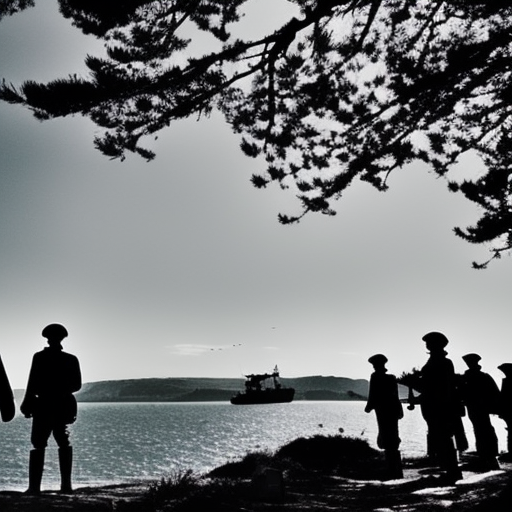Landing at Anzac Cove: A Failed Invasion
The landing at Anzac Cove, also known as the Gallipoli landings, was a military operation conducted by the Allied forces during World War I. The aim was to capture the Gallipoli Peninsula in modern-day Turkey from the Ottoman Empire. The operation began on April 25, 1915, and resulted in a failed invasion that led to significant casualties on both sides.
Background
The Allied forces, primarily consisting of troops from Australia and New Zealand, known as the ANZACs (Australian and New Zealand Army Corps), were part of a larger plan to open up a new front against the Central Powers. The objective was to secure the Dardanelles Strait and provide a supply route to Russia, while also diverting Ottoman forces from other fronts.
The Landing
On the morning of April 25, 1915, the ANZACs landed at Anzac Cove, a small beach on the western side of the Gallipoli Peninsula. The landing was met with fierce resistance from the well-prepared Ottoman defenders. The rugged terrain and steep cliffs made it difficult for the ANZACs to advance, and they soon found themselves pinned down on the beach.
Fierce Fighting and Stalemate
Over the next several months, both sides engaged in intense fighting. The ANZACs, despite their initial setback, managed to establish a tenuous foothold on the peninsula. However, their attempts to break through the Ottoman defenses and advance inland were repeatedly repulsed.
The fighting at Gallipoli was characterized by trench warfare, similar to the Western Front in Europe. Both sides dug in and fortified their positions, resulting in a stalemate. The rugged and inhospitable terrain made it difficult for either side to gain a significant advantage.
Conditions and Casualties
The conditions at Gallipoli were harsh and unforgiving. The troops had to contend with extreme heat, lack of fresh water, and unsanitary living conditions. Diseases such as dysentery and typhoid were rampant, further adding to the hardships faced by the soldiers.
Casualties on both sides were high. The ANZACs suffered heavy losses, with over 8,000 killed and more than 18,000 wounded. The Ottoman forces also suffered significant casualties, with estimates ranging from 60,000 to 87,000 killed or wounded.
Evacuation
Realizing that the campaign was not going as planned and that the objectives were unlikely to be achieved, the Allied command decided to evacuate the troops from Gallipoli. The evacuation was carried out in secret and under the cover of darkness to avoid alerting the Ottoman forces.
The evacuation began in December 1915 and was completed by January 1916. Despite the challenging circumstances, the evacuation was remarkably successful, with the ANZACs managing to withdraw without suffering heavy casualties.
Legacy
The landing at Anzac Cove and the subsequent campaign at Gallipoli had a profound impact on the nations involved. The ANZACs, in particular, saw the campaign as a defining moment in their national identity. The bravery and resilience displayed by the troops in the face of adversity became a source of inspiration and pride.
The Gallipoli campaign also had wider implications. It highlighted the difficulties of conducting amphibious operations and the importance of thorough planning and coordination. The failure of the campaign led to changes in military strategy and tactics, particularly in the areas of amphibious warfare and combined operations.
In conclusion, the landing at Anzac Cove was a failed invasion that resulted in significant casualties and a protracted stalemate. The campaign at Gallipoli had a lasting impact on the nations involved and influenced military thinking in the years to come. Despite its failure, the bravery and determination displayed by the ANZACs continue to be remembered and honored to this day.












